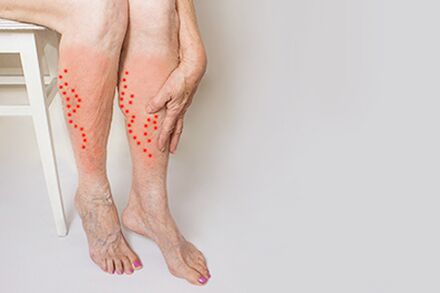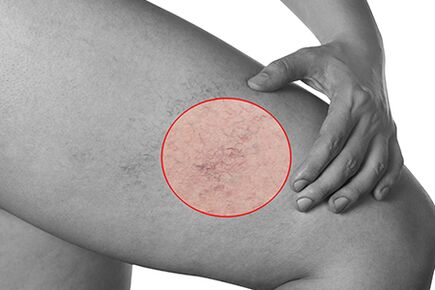If the veins in the legs are very large and clearly visible to the naked eye, this is no reason to be proud (well, in fact, they are not muscles). However, they do not look as attractive as, for example, the quadriceps. Therefore, most people usually hide them. Even from doctors. Which, by the way, is a complete lie. Because if you have any problems with the condition of blood vessels and blood vessels, then you need to see a specialist - phlebologist. But first read this article: then you will learn how to treat varicose veins in the legs, what are the symptoms and what procedures are performed to eliminate it.
Varicose veins of the legs: symptoms

The symptoms of this disease depend on its stage:
Thus, in the first stage, the patient is bothered by a feeling of heaviness in the lower extremities, muscle cramps (more often during sleep), itching or burning, swelling of the legs. Sometimes there is pain in the legs, especially in the area of the veins. There are frequent teleinjections.
In the second stage, there are vascular networks and all the symptoms characteristic of the first stage, but it is already more pronounced. Also, the visibility of the vessels increases significantly: they can be observed even with the naked eye.
The third stage is characterized by all of the above symptoms. At the same time, the swelling is almost permanent. Sometimes they can pass in the morning, but at the same time they appear again in the evening.
In the fourth stage, the skin changes color. It can be brown or even black. Inflammation appears, skin atrophy is possible. In this case, blue or purple spots appear on it.
In the fifth and sixth stages, a trophic ulcer is formed: healed and unhealed, respectively.
Varicose veins of the legs: treatment
Today, varicose veins in the legs can be treated in several ways:
Laser obliteration of blood vessels. This is a high-tech procedure performed using modern equipment - a medical laser device. The device is equipped with a flexible light guide that enters the lumen of the problem vessel to a certain depth through a puncture or incision. After that, the phlebologist starts the device and the tip of the light guide begins to emit a continuous stream of light. Light has such a wavelength that the rays are absorbed by the walls of the vessels, resulting in heating and soldering. Control of the procedure with the help of ultrasound laser allows to treat varicose veins in the legs more accurately and effectively. After a while, the adherent veins melt. The light guide has a special design, thanks to which the entire interior of the ship is processed immediately. The required duration of treatment is achieved due to the gradual removal of the light guide by the doctor. The average duration of a laser ablation session is 2-4, 5 hours, but this concern is compensated by the fact that varicose veins can be treated with only one laser ablation session. Because the procedure requires a small incision (no more than 0. 3 cm), there is no need to sew after the session.
Miniflebectomy. This procedure will also require a puncture or incision (also not more than 3 mm). It is necessary to remove the affected area of the vessel. After that, the phlebologist excises the removed vein and compresses the ends. Treatment of varicose veins of the legs with this procedure does not involve suturing, because the puncture is small - it is usually covered with plaster and wrapped. This is enough for treatment.
Sclerotherapy. You do not need to make an incision for this procedure - the session can be completely injected. Using a syringe, a special liquid (or foam) is injected into the skin that sticks to the walls of the blood vessels. As with laser vein obliteration, the adherent vein dissolves in the tissues over time.
Surgical treatment of varicose veins in the legs. This operation is performed under local anesthesia. During the operation, the doctor cut the skin in the area of the removed vessels, and then removed them. In addition, the cause of the backflow of blood is eliminated at the same time. After surgery, a fairly long recovery period is required, accompanied by a mandatory dressing.
Remember that after all procedures, you must follow certain instructions given by your doctor after their completion. So, for several months after the treatment of varicose veins of the legs, it is necessary to refrain from any vaccinations, not to go to the sauna or bath. It is also forbidden to stand or sit for long periods of time. To achieve the effectiveness of the procedure, as well as during a faster rehabilitation, a special point is to wear compression underwear. At the same time, it is enough to follow this rule day and night for the first few days. In the future, compression underwear can be worn only during the day. By the way, first you need to give up uncomfortable shoes (high heels, narrow). Two or three weeks after the procedure, it is recommended to wear comfortable and wide shoes.
Causes of varicose veins

One of the main reasons for the appearance and development of varicose veins of the legs, experts call a genetic predisposition. Thus, if one of the relatives is diagnosed with varicose veins, the risk of this disease will be significantly higher than in people whose relatives do not suffer from varicose veins. However, there are many other factors that contribute to the development of varicose veins in the legs:
Sedentary lifestyle.
Wear uncomfortable shoes or high heels.
Deferred foot injuries.
Increased loads: overweight, weight lifting.
Malnutrition.
Pregnancy and childbirth.
Diseases of the cardiovascular system.
Weakened vascular tone.
Taking certain hormonal medications.
Smoking and alcohol abuse.
Diseases of the pelvic organs.
Constant stress and emotional tension.
High blood viscosity.
Varicose veins are more common in older people (because the vascular tone decreases with age). However, it can be seen in young people under 30 years of age. The disease affects both sexes.
Why you should treat varicose veins in the legs
When varicose veins in the legs are not removed (treated) in time, various complications are possible, including untreated trophic ulcers. Such an ulcer can later lead to gangrene, which can already be fraught with amputation and disability of the lower extremity. In addition, the treatment of any disease is easier to implement in the early stages of the disease.
Also, do not forget about the possible development of thrombophlebitis. One of the complications of this disease is pulmonary embolism, which can usually be fatal.
Prevention of varicose veins in the legs
A good preventative measure for varicose veins in the legs is to wear compression underwear that can provide uniform pressure over the entire surface of the legs. It is also recommended to follow other recommendations:
Do not neglect sports activities: cycling, swimming, walking, etc.
Avoid uncomfortable shoes (especially high heels).
Take a contrast shower.
In addition, if you have a genetic predisposition to varicose veins (or other factors), consult a phlebologist at least twice a year.


















